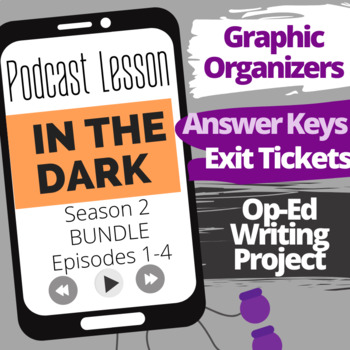In the Dark: Season 2, Episodes 1-4 Bundle
- Zip
- Internet Activities
What educators are saying
Products in this Bundle (5)
Also included in
- This podcast bundle has a little bit of everything with many opportunities to use the resources throughout the year! Some lessons take weeks, while others can be completed in one or two days - whatever works best for you!Here are the products included:Scary Podcasts for High School Students - one ofPrice $48.80Original Price $61.00Save $12.20
Description
If your students love Serial, wait until they hear In the Dark!
This bundle goes with the first four episodes of the second season which explores how Curtis Flowers has been tried for the same murder case six different times over a 21 year period. They'll really be shocked when they hear he was behind bars up until December 2019 even though each of his trials has resulted in a hung jury or an overturned conviction from the Supreme Court.
Episode one details the basics of the crime scene, the evidence against Curtis Flowers, the suggested motive for the murder, and the many inconsistencies and errors that have occurred during the trial.
Episode one product includes the following:
- Graphic organizer for students to take notes on all the important information. A QR code is included at the top of the organizer for easy access to the podcast. I also include the times for each section so students (and teachers) know exactly where to find the information and can quickly refer back to the podcast as needed.
- An answer key for the graphic organizer
- Three different versions of exit tickets to focus on three different common core standards: differentiate based on your students' needs, let your students pick their exit tickets, or have students complete all three. Exit tickets include a quick rubric at the bottom for easy grading and student reference for what is expected in their response.
In episode two students will hear all about the route Curtis allegedly took the morning of the murders and they'll hear from the witnesses who testified to seeing Curtis along the route that day.
Episode two product includes the following:
- Graphic organizer for students to take notes on all the important information. A QR code is included at the top of the organizer for easy access to the podcast and online map. I also include the times for each section so students (and teachers) know exactly where to find the information and can quickly refer back to the podcast as needed.
- An answer key for the graphic organizer
- Three different options for having students rank witness credibility: whole-class ranking using the floor or whiteboard, individual ranking with Post-It template to encourage discussion and changing of opinions during discussion, and four corners activity to get students moving around while ranking and discussing witness credibility.
- A written response where students identify the least and most credible witnesses. Students must include specific details from the podcast to support their claim.
Episode three is all about the gun and there is a lot of information to cover. I've split up the episode into meaningful sections to help students make connections and inferences about the case. The graphic organizer has students taking notes on information presented mixed with questions that require them to extend their thinking beyond a basic recall of facts.
Episode three product includes:
- Graphic organizer to take notes on all the important information from the episode.
- An answer key for the graphic organizer
- Station labels and additional photos, links, information, or guide questions for students to explore if they finish their station early.
- Exit ticket with a basic rubric on the bottom to help ease grading.
In episode four students will hear about three different people who claim Flowers confessed to them while in prison. However, all three have changed their stories and taken back their confessions. Only one of three changed his mind again (three times!) and continues to stand trial against Flowers.
Episode four product includes the following:
- Graphic organizer for students to take notes on all the important information. A QR code is included at the top of the organizer for easy access to the podcast. I also include the times for each section so students (and teachers) know exactly where to find the information and can quickly refer back to the podcast as needed.
- An answer key for the graphic organizer.
- Stopping points and discussion topics to use throughout the episode.
- Exit ticket: A written response where students argue if jailhouse informants (snitches) should be used as evidence during trials. Students must include specific details from the podcast to support their claim.
****This episode contains graphic language because people are quoting each other. The creators of the podcast leave the language in because it is part of the evidence presented against Flowers. I make note of what section the language appears and what words are said so instructors are aware of what is coming****
In the Dark podcast is the perfect informational text to pair with an op-ed writing assignment because students always have such strong opinions about the topics discussed on the podcast.
Op-Ed writing product includes:
- Graphic organizer with link to the American Bar Association to research different possible sanctions that can be placed on a lawyer for misconduct. (answer key included)
- Graphic organizer to sort information pulled from episodes 1-4. Students list out the different factors that should be considered when looking at placing sanctions on a lawyer. Factors to consider are also from the American Bar Association. (answer key included)
- Link to an op-ed mentor text and graphic organizer to help identify persuasive techniques used and their purpose.
- Mentor text exit ticket.
- Op-ed assignment instructions with specific details on what must be included.
- Two pages of teacher notes and instructions.






